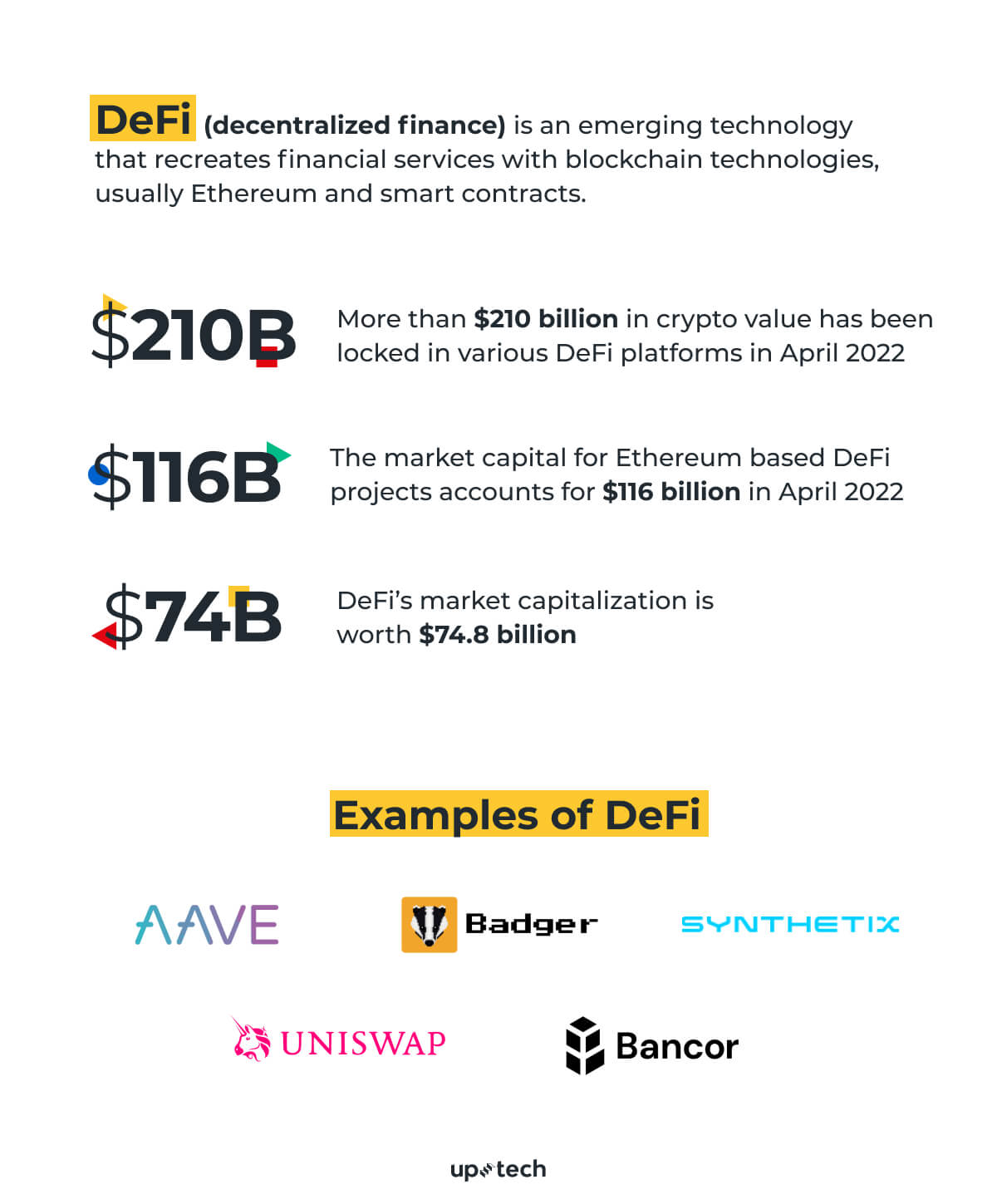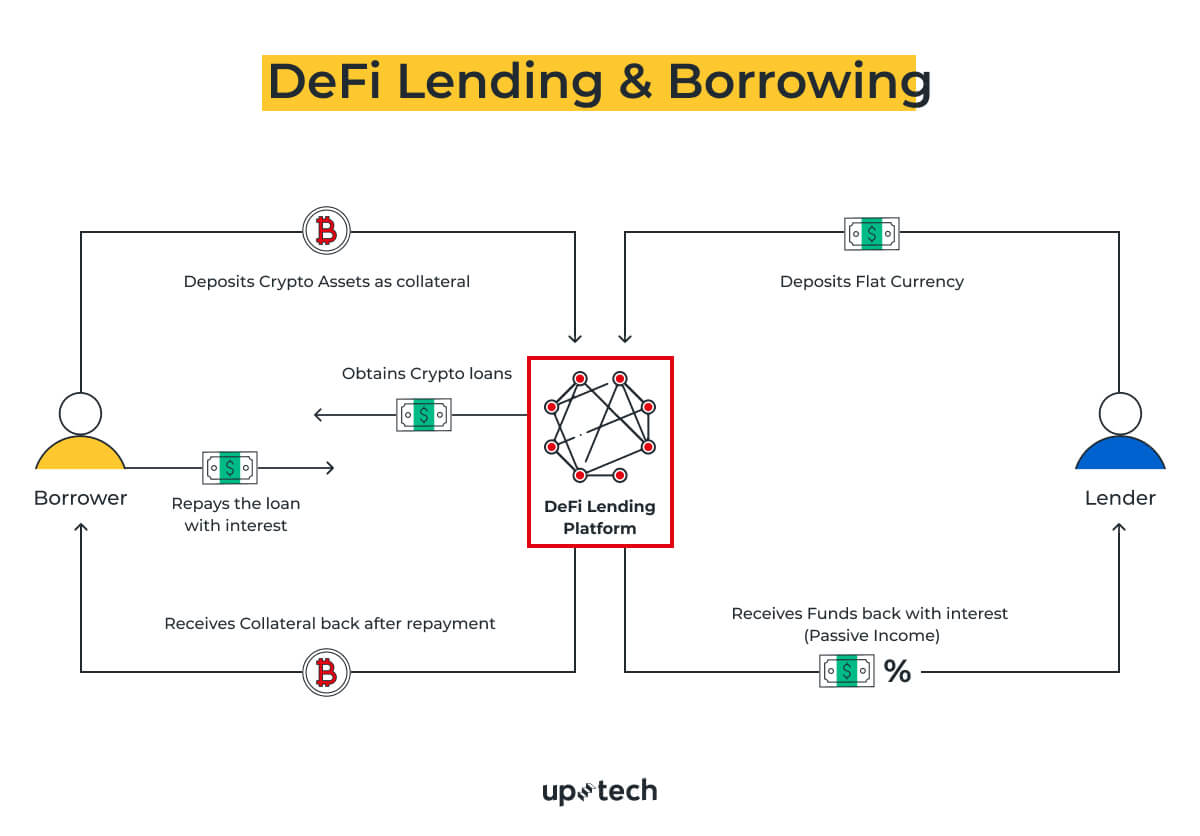The fintech industry is booming, and the focus is on a particular niche called DeFi. Despite being a relatively new market, DeFi has charted more than $83 billion in smart contracts' total value locked in March 2022. Given the crypto community's enthusiasm, it is natural that you've set sight of launching a startup in the DeFi market.
What is DeFi?
DeFi is an acronym for decentralized finance. It is an emerging technology that recreates financial services with blockchain technologies, usually Ethereum and smart contracts. Like conventional banking, DeFi allows users to perform financial transactions, such as transfers, lending, investing, trading or savings.
However, DeFi allows consumers access to these financial facilities without the presence of an intermediary entity. There is no brokerage, exchange, or financial institution involved in the DeFi ecosystem. This allows DeFi's application to go beyond conventional boundaries, making it accessible across markets, regions, and different layers of society.

DeFi was first introduced in 2018 by a group of Ethereum developers and entrepreneurs in a bid to provide an equal-opportunity financial landscape for the public. In conventional banking, the intermediary institution possesses authoritative power in overseeing the transactions. DeFi is the antithesis of traditional finance, which deny particular groups of people access to basic financing instruments.
Defi by Numbers
So far, the figures have been encouraging in terms of interest in DeFi amongst investors and users alike. More than $210 billion in crypto value has been locked in various DeFi platforms in April 2022. The market capital for Ethereum-based DeFi projects accounts for $116 billion for the same period.

In 2021, Forbes reported that DeFi’s market capitalization is worth $74.8 billion, indicating that the industry is gaining strong momentum. According to Mark Cuban, the DeFi industry is poised for explosive growth in the next decade. MakerDAO, the developer of DAI stable coin, is leading the pack after securing $6 billion in investments.
DeFi’s potential challenge to traditional financial instruments is marked by astounding transactions in the Ethereum blockchain, worth $11.6 trillion, in 2021. The figure surpasses those of Visa, currently the second-largest payment processor globally. DeFi investors believe that current statistics show that there are still many untapped opportunities in DeFi as only 5% of 221 million crypto users are actively using its services.
Examples of DeFi apps
These DeFi apps disrupt traditional financial markets and strengthen the DeFi ecosystem in creative ways.
Aave
Aave is a decentralized landing protocol that provides liquidity and equal opportunity for borrowers and lenders. Lenders can borrow with minimum collaterals while earning rewards by injecting capital into the Aave protocol.
Badger
Badger intends to bring Bitcoin into the DeFi market. It does so by allowing users to deposit Bitcoins in various products in exchange for yield generation.
Synthetix
Synthetix delivered the future of broker-less trade exchanges. It allows investors to participate in global markets, stocks, and commodities and provides instruments to create asset-backed digital assets called ‘synths’.
Uniswap
Uniswap is a crypto trading protocol that allows users to buy and increase liquidity in the crypto market. It primarily lets users trade between ETH and ERC-20, which is used to fuel smart contracts on the blockchain ecosystem.
Bancor
Bancor provides users with a peer-to-peer cryptocurrency swap mechanism without going through a centralized exchange.
Benefits of DeFi
DeFi ventures have managed to secure significant investment from serious backers. There is much optimism in the air about how DeFi is reshaping the traditional financial landscape. The core of the DeFi ecosystem lies in blockchain technologies. Blockchain ensures transparency in protocols to secure crypto transactions and prevent fraudulent exchanges.
Consumers are seeking alternative financing facilities in the modern world without the usual bureaucratic red tapes. DeFi is a financing system built and governed by program codes. As such, you can transfer funds, invest in commodities, or secure loans in a matter of clicks. DeFi provides the efficiency that is lacking in manual approval and verifications.

As a decentralized system, DeFi users can access their funds in any part of the world. They are the true owners of digital assets and have full authority in how they manage their crypto wallets. Without an intermediary party, users enjoy lower transaction fees, higher returns, and visibility on all transactions performed.
What are the main elements of DeFi?
DeFi applications are built on different layers of technologies or DeFi tech stacks. Each layer dictates a specific function of the app to provide, secure, and manage transactions across the blockchain infrastructure. Together, the DeFi technological elements provide functionalities that enable secure, transparent, and immediate transactions.
Settlement Layer
The settlement layer forms the foundation of the DeFi infrastructure. Also known as layer 0, it consists of a public blockchain network and a specific cryptocurrency for supporting the transactions. For example, most DeFi apps are built on the Ethereum blockchain and use Ether as the native currency. In some cases, DeFi apps use a tokenized version of digital assets, which provides a fractional value of real-world assets.
Protocol Layer
Despite operating without a central regulatory body, transactions in the DeFi ecosystem must adhere to agreed rules and regulations. This is provided by the protocol layer, which contains agreed rules that support interoperability between various DeFi services. DeFi protocols are made available to developers to introduce new DeFi services and prevent monopoly by any party.
Application Layer
The application layer is the front-facing part of the DeFi app. It abstracts the functionality of the underlying protocol layer and presents users with intuitive functions and services. For example, developers build crypto-wallet, exchanges, lending, and other services on the application layer.
Aggregator Layer
DeFi’s skyrocketing growth is attributed to how various services can be brought together and add value to crypto users. This is what the aggregator layer is all about. It integrates different services in the application layer and provides a seamless transactional experience. For example, users can deposit capital in their wallets, trade with a different cryptocurrency, and stake it against digital assets.
How Does DeFi Work
DeFi allows people to transfer money, secure a loan, invest in derivative stocks, and engage in other financial activities by doing away with intermediaries. There is no longer a bank manager, broker, guarantor, or other middle agent involved in a DeFi transaction. These peer-to-peer, quick, and often economic transactions are made possible with smart contracts and blockchain technologies.

Smart contracts are program codes that replace the roles of intermediaries. Instead of vetting through financial documents and checking credit scores, DeFi apps permit a transaction once both parties satisfy the condition in the smart contract. Users are not subjected to lengthy approvals or burdensome requirements to access certain financial products.
Due to its transparent technologies, various fintech startups continue to expand and provide new DeFi products to users. Many DeFi apps are in the form of stablecoins, which peg certain cryptocurrencies against their real-world counterparts to reduce volatility. DeFi applications have also permeated lending, insurance, trading, exchanges, betting, and other traditional markets.
What The Future Holds For DeFi in Fintech
There's no denying that the advent of DeFi is driving the financial industry into uncharted territories. DeFi startups are on an upward trajectory that will shape the future of finance. It is still too early to predict the net effect of decentralized finance, but early signs have revealed both its pros and cons.
Optimism Abound for DeFi
DeFi has pried open the closed-door model in which conventional banking and financial services operate. It makes intermediaries redundant and replaces them with smart contracts that lower the cost of services to users. The dramatic introduction of DeFi apps, including stablecoins, central exchanges, and lending instruments, has opened up new markets.
Like it or not, banks, insurers, investment firms, and mortgage providers can't ignore DeFi's meteoric growth. Dismissing the new-age blockchain financing ecosystem is unwise and could shrink market share. Crypto experts predict that many banking facilities will eventually shift to DeFi platforms.

Pitfalls of DeFi
Despite the optimism in conversations surrounding DeFi development, the smart-contract blockchain ecosystem is still in its infancy. There are concerns that DeFi’s pseudonym-based transaction will encourage money laundering and other criminal offenses. Financial regulators are several steps behind addressing potential issues that might arise with DeFi usage.
Cryptocurrency’s volatility means an inherent risk of losing capital when participating in yield-generating schemes in the DeFi market. Investors must be well-informed of the crypto market risk exposure, as every DeFi app operates with a unique business model. Tax submission might get complicated due to non-standardized regulations.
Summary
Given DeFi’s immense popularity, you must be strategic when planning your fintech product. Weigh both the pros and cons of decentralized finance and consider how you could capitalize on its momentous growth. Assess regulatory risks, investors’ appetite, and potential collaboration with the traditional finance sector as you ponder on the idea of its borderless counterpart.
Once you have clarity, seek out our team at Uptech to bring your idea to fruition.































